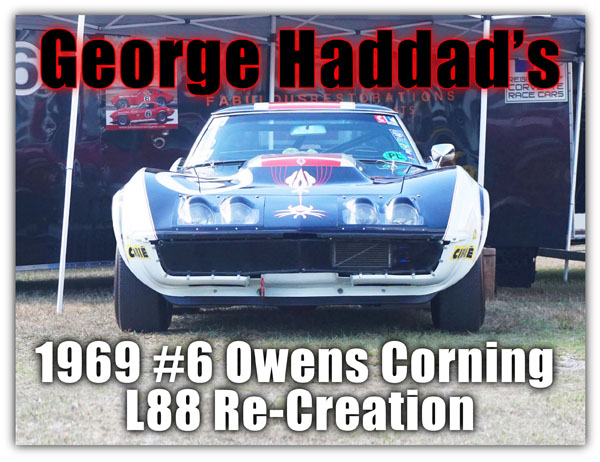Dateline: 8-3-22, Photos by K. Scott Teeters, except where noted. This story first appeared in the July 2022 issue of Vette Vues Magazine – When you grow up in Detroit in the ’50s and ’60s “cars” are in your soul. That was George Haddad’s. By the age of four, he could call out car names in his neighborhood, Grosse Pointe, a suburb of Detroit. As a teenager, Woodward Avenue was his hangout. Zora and Alfie Duntov lived there too.
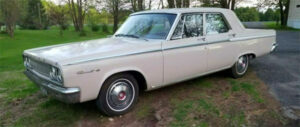 George’s dad got him his first car, a six-cylinder 1965 four-door Dodge with little hubcaps. George said to himself, “That won’t do!” He had some money saved and promptly bought a 1964 Max Wedge Plymouth Fury with a four-speed, and no frills, just horsepower.
George’s dad got him his first car, a six-cylinder 1965 four-door Dodge with little hubcaps. George said to himself, “That won’t do!” He had some money saved and promptly bought a 1964 Max Wedge Plymouth Fury with a four-speed, and no frills, just horsepower.
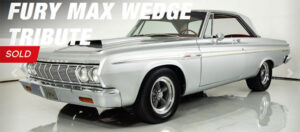
After a $29.95 Earl Schelb paint job, George was ready for Woodward Avenue cruising and drag racing. “I was a Mopar guy and street machines weren’t pretty then, no one had any money. Once I took the car to Detroit Dragway and ran 13.2, but I was in the street scene, that’s what you did all summer.”
A few years later George was working for Chrysler when a friend that worked at the GM Tech Center got a new Rally Red 1968 Corvette Convertible. “I was crazy about my friend’s Corvette, it looked like a car from another world, and I had to have one. So I bought a used ’68 327 Corvette Convertible with a four-speed and no options.”
 George meets an “old guy” with an odd Corvette
George meets an “old guy” with an odd Corvette
Here’s how George met Zora Arkus-Duntov one day in town. “My car buddies and I would hang out together with our Corvettes along the curb in town and we’d see an old guy drive by in a white Corvette but didn’t know who he was. Zora was home recuperating from surgery and sometimes he’s stop and talk to us because he could see we were all Corvette guys. First of all, I couldn’t understand him. I kept wondering, who is this eccentric old guy?
 It turned out that the Corvette was Zora’s 454 all-aluminum big-block LT-2 mule car with flares, racing wheels, and tires. I didn’t like the flares and wondered why anyone would do that. But he’d tell us details about why things were the way they were on the Corvettes. Later I learned who he was and why he was so important and was blown away.”
It turned out that the Corvette was Zora’s 454 all-aluminum big-block LT-2 mule car with flares, racing wheels, and tires. I didn’t like the flares and wondered why anyone would do that. But he’d tell us details about why things were the way they were on the Corvettes. Later I learned who he was and why he was so important and was blown away.”
Off to work at Chrysler in the freezing cold
By 1973 George was working for Chrysler in management because he was going to college majoring in architecture. “I wanted to properly learn to build cars on the production line, and I didn’t want to be management and drawing gears. So on the weekends, I’d fly to Fort Lauderdale to get away from the cold every other weekend. One winter night when I left second-shift work, when I got to the parking lot, there was ten inches of snow and an inch of ice on my Roadrunner.”
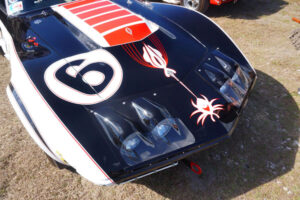 “My door was iced up, so I chipped the ice and worked a lighter to unlock the door. And it’s really cold, too! So I moved to Fort Lauderdale and went to school for the next two-and-one-half years. And because I was in management, Chrysler kept paying me! When my education was completed, Chrysler said I had to come back to Detroit. So I stayed for six weeks and quit. I thought why would anyone want to live and work in this climate? I packed up my stuff and went back to Fort Lauderdale. That was 1973 and I’ve been here ever since.”
“My door was iced up, so I chipped the ice and worked a lighter to unlock the door. And it’s really cold, too! So I moved to Fort Lauderdale and went to school for the next two-and-one-half years. And because I was in management, Chrysler kept paying me! When my education was completed, Chrysler said I had to come back to Detroit. So I stayed for six weeks and quit. I thought why would anyone want to live and work in this climate? I packed up my stuff and went back to Fort Lauderdale. That was 1973 and I’ve been here ever since.”
Life in warm, sunny, Fort Lauderdale, Florida
Needing a job, George went to work for a guy that owned a local Shell and a Pro Stock Vega. George recalls, “I was doing mechanical work at the Shell station and wasn’t really into drag racing, but it kept me around performance cars. Custom paint jobs were very popular, so I learned how to do paint and glass work. I bought a 1974 Corvette to customize and enter into the World of Wheels Show.”
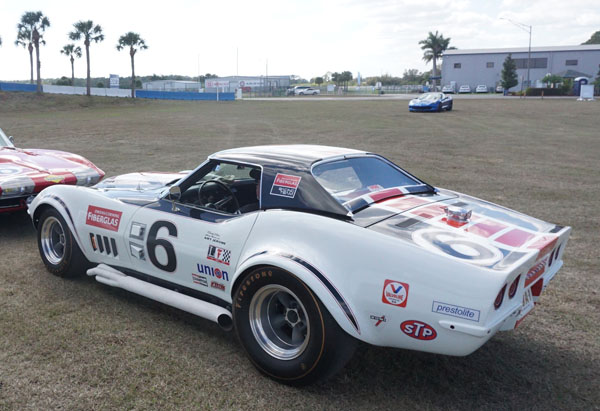
“I didn’t like the ’74’s bumper covers, so I put ’75 fiberglass bumper covers on the car. I felt Chevy lifted the ’69-to-’75 “sugar-scoop” roof design from Ferrari, so I made it a real fastback from the B-pillar back, with the roof section of a ’66 Corvette coupe. Then I painted the car Dark Diamond Metallic Lincoln Brown from the belt line up and beige on the lower section. I entered the World of Wheels and took 1st Place. That win helped me get work from guys that wanted to be in car shows, so I opened Fabulous Finishes, in Hollywood, Florida.”
Fabulous restorations is born
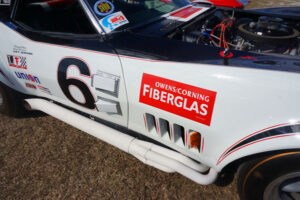 Later George changed the name of his business to Fabulous Restorations and is now in Fort Lauderdale, his fifth location, his biggest and best. George and his wife Adele opened the new shop in 2017. The shop is a car guy’s palace; neat, tidy, super organized, and decorated; with 20,000 square-feet; 15,000-feet on the floor, and 5,000-feet off the floor. Fabulous Restorations is a full-service hot rod restoration shop.
Later George changed the name of his business to Fabulous Restorations and is now in Fort Lauderdale, his fifth location, his biggest and best. George and his wife Adele opened the new shop in 2017. The shop is a car guy’s palace; neat, tidy, super organized, and decorated; with 20,000 square-feet; 15,000-feet on the floor, and 5,000-feet off the floor. Fabulous Restorations is a full-service hot rod restoration shop.
The seed for doing re-creations was planted when a customer wanted a re-creation of a 1969 COPO Camaro, but with a modern ZZ427 Crate engine. George got the ZZ427 modern version of the classic 1969 ZL1, sourced the correct parts that would have gone into an original ’69 COPO Camaro, built the car, and the customer drove away happy. The project got George wondering; “What would be the most awesome re-creation Corvette?” When you know your Corvette history, the answer is easy; a 1969 427 ZL1.
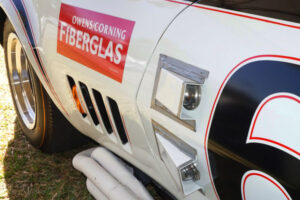 With nearly fifty-years of experience building cars, George has seen trends come and go. “We will take on almost any kind of car, but I especially love Corvettes. I’ve done a lot of NCRS-type cars and restorations, so I know the factory parts. I especially like the C2 and C3 big-block Corvettes. That’s what motivated me to do my first re-creation Corvette, the LeMans Blue ZL1. I have never said the car IS a ZL1, I’ve always said it is a re-creation, built “as if” it had been assembled in St. Louis with all of the correct parts that went into an L88 with the ZL-1 option.”
With nearly fifty-years of experience building cars, George has seen trends come and go. “We will take on almost any kind of car, but I especially love Corvettes. I’ve done a lot of NCRS-type cars and restorations, so I know the factory parts. I especially like the C2 and C3 big-block Corvettes. That’s what motivated me to do my first re-creation Corvette, the LeMans Blue ZL1. I have never said the car IS a ZL1, I’ve always said it is a re-creation, built “as if” it had been assembled in St. Louis with all of the correct parts that went into an L88 with the ZL-1 option.”
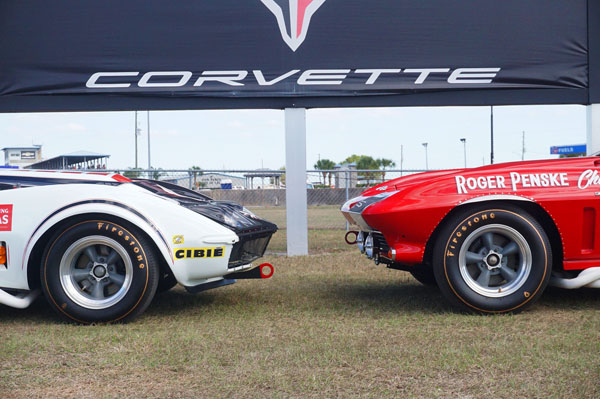
 George’s 1969 427 ZL-1 Re-Creation
George’s 1969 427 ZL-1 Re-Creation
According to the Corvette Blackbook, the “official” 1969 ZL1 production was TWO. RPO ZL1 was an aluminum block version of the aluminum-head L88 racing package that included racing-level suspension and brake parts. This was to be Duntov’s ultimate racing Corvette; big-block power at small-block weight. George’s re-creation 1969 ZL1 is mechanically as accurate as can be, but to make the car more visually interesting, he added period-correct racing side-pipes, American Racing mag wheels, and Goodyear racing tires. The car was featured in the January 2016 issue of Vette Vues.
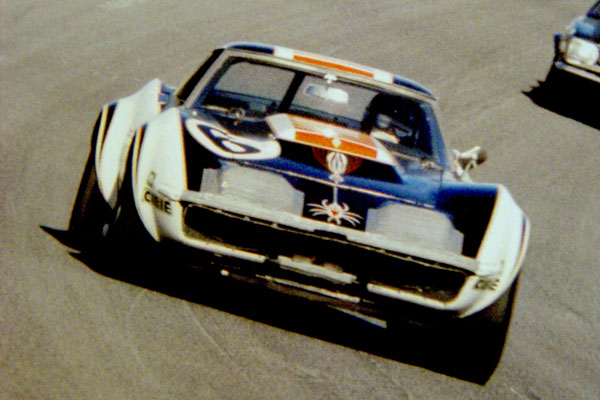
George’s Owens-Corning 427 L88 Re-Creation Project
George now had a taste for accurate re-creations. You can’t be this intimate with Corvettes and not appreciate the great L88 road racing cars. The winningest Corvette team ever was the Jerry Thompson and Tony DeLorenzo Owens-Corning L88 Corvettes. From May 1969 to November 1970 the two-car O-C team won 22-straight races. Competitors used to half-jokingly say, “Wonder who will take 2nd today?”
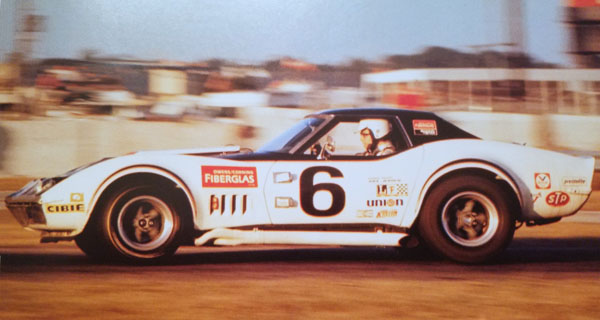
Thompson and DeLorenzo were both outstanding drivers and took turns with the team’s wins. DeLorenzo was a GM V.P. Of Public Relations, Thompson was a GM Engine Development Test Engineer and basically ran the team operations. While it is true that they had some strong inside help, the guys delivered the goods.
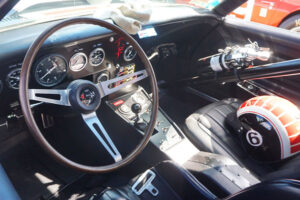 One day General Curtis LeMay, Ret. was the Chairman-of-the-Board of Owens-Corning Fiberglas, got a call from Dollie Cole, GM President, Ed Cole’s wife. Mrs. Cole suggested that LeMay should sponsor Thompson and DeLorenzo’s racing activities. As Chevrolet executives, Thompson and DeLorenzo had access to Duntov’s latest, greatest go-fast parts. Zora’s right-hand-man, Gib Hufstadder was the go-between-man for the team. GM Stylist, Randy Wittine designed all of the liveries and pinstriped the cars.
One day General Curtis LeMay, Ret. was the Chairman-of-the-Board of Owens-Corning Fiberglas, got a call from Dollie Cole, GM President, Ed Cole’s wife. Mrs. Cole suggested that LeMay should sponsor Thompson and DeLorenzo’s racing activities. As Chevrolet executives, Thompson and DeLorenzo had access to Duntov’s latest, greatest go-fast parts. Zora’s right-hand-man, Gib Hufstadder was the go-between-man for the team. GM Stylist, Randy Wittine designed all of the liveries and pinstriped the cars.
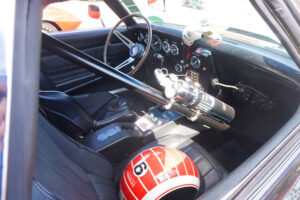 Thompson and DeLorenzo’s total domination
Thompson and DeLorenzo’s total domination
Thompson and DeLorenzo raced a ’67 L88 Corvette and wanted to start the sponsorship with a ’68 L88, but they were all sold. So they decided to build their own L88. Years later Thompson said in an interview, “Avoid this. We broke every rotating part in the drive-train, suspension, and brake system. We referred to the ’68 L88 as “the Mongrel”. Later they added a “real” 1969 L88 to replace the ’67 L88 that Tony’s father, Tony DeLorenzo, Sr. was able to order for the guys.
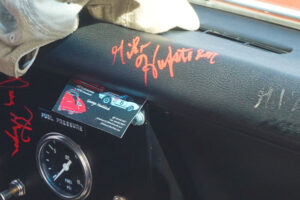 But nothing was “easy” just because they had help. The team raced in SCCA A/Production class and FIA GT Classes. At tracks across the country, both cars were raced hard, thrashed, bashed, and occasionally spectacularly crashed. Between races, the guys rebuilt the cars and soldiered on. After long 12 and 24-hour races, the frames were wiped-out and replaced.
But nothing was “easy” just because they had help. The team raced in SCCA A/Production class and FIA GT Classes. At tracks across the country, both cars were raced hard, thrashed, bashed, and occasionally spectacularly crashed. Between races, the guys rebuilt the cars and soldiered on. After long 12 and 24-hour races, the frames were wiped-out and replaced.
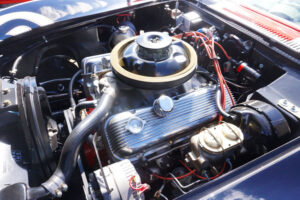 Before long, there was very little factory-Corvette left. Thompson and DeLorenzo scored 1st in GT Class and 6th overall at the 1970 24 Hours of Daytona and Class wins at the 12 Hours of Sebring. After their 1971 1st in Class and 4th over win at Daytona, Owens-Corning changed their marketing program and canceled the sponsorship. Both cars were sold off to other racers, and today are part of the collections of Harry Yeaggy, and Rick Hendricks.
Before long, there was very little factory-Corvette left. Thompson and DeLorenzo scored 1st in GT Class and 6th overall at the 1970 24 Hours of Daytona and Class wins at the 12 Hours of Sebring. After their 1971 1st in Class and 4th over win at Daytona, Owens-Corning changed their marketing program and canceled the sponsorship. Both cars were sold off to other racers, and today are part of the collections of Harry Yeaggy, and Rick Hendricks.
So, for George’s next re-creation project he decided to take on a configuration of the Owens-Corning Corvette No. 6 (the ’69 L88) wearing the 1970 24 Hours of Daytona livery. Previous Randy Wittine-designed O-C cars wore a similar block-stripe pattern, but in red and white to match the Owens-Corning Fiberglas logo. Wittine’s 1970 Daytona livery had white sides, a black upper portion, with a white center stripe, and red blocks. Owens-Corning was not happy and demanded they return of the strictly red and white livery. What we see here was a one-race livery.
 So, why did George go with this livery and not the subsequent cars that today are in private collections? George explained, “I went with this design because it doesn’t exist anymore, it’s gone. Besides, I didn’t want my re-creation to compete with the restored real cars. It’s a re-creation of how the cars looked at a historically important team win at the 1970 24 Hours of Daytona race. Their production-based cars outlasted a lot of bigger, faster, purpose-built, name race cars.”
So, why did George go with this livery and not the subsequent cars that today are in private collections? George explained, “I went with this design because it doesn’t exist anymore, it’s gone. Besides, I didn’t want my re-creation to compete with the restored real cars. It’s a re-creation of how the cars looked at a historically important team win at the 1970 24 Hours of Daytona race. Their production-based cars outlasted a lot of bigger, faster, purpose-built, name race cars.”
The 1970 Daytona Corvette number 7 was the ’68 “mongrel” L88 and number 6 was the ’69 L88 that Tony’s dad helped the guys buy. During the race, number 6 suffered a wheel studs failure that ejected the tire, and shredded the back half of the right rear fender. Tony had to hustle back to the pits for tools and replacement studs to repair the car himself so he could drive back to the pits for a proper repair.
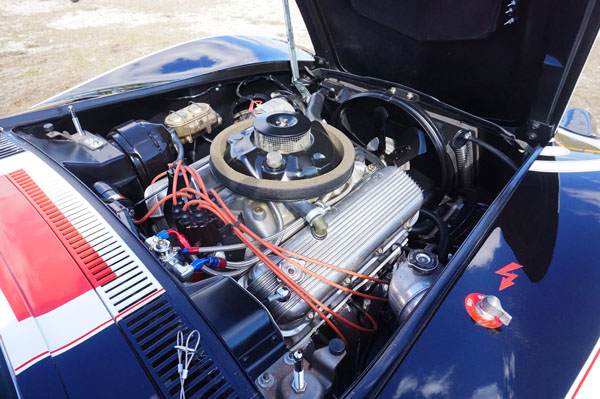 Those were the rules for the Daytona race then, if a car broke on the track, the driver had to fix the car if he could. The number 7 L88 took the GT Class win. In retrospect, George says he should have painted his re-creation with the number 7.
Those were the rules for the Daytona race then, if a car broke on the track, the driver had to fix the car if he could. The number 7 L88 took the GT Class win. In retrospect, George says he should have painted his re-creation with the number 7.
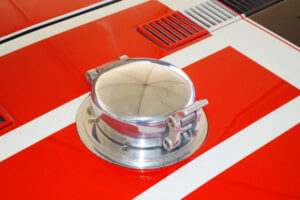 I asked George about the donor car for the project and he said, “There was no donor car, I had most of the basic parts from years of Corvette projects. What I didn’t have, I sourced, which was not easy because I wanted all of the parts to be authentic; no aftermarket pieces, the real stuff. The hood, suspension, shocks, and brake parts are all real GM period-correct parts.”
I asked George about the donor car for the project and he said, “There was no donor car, I had most of the basic parts from years of Corvette projects. What I didn’t have, I sourced, which was not easy because I wanted all of the parts to be authentic; no aftermarket pieces, the real stuff. The hood, suspension, shocks, and brake parts are all real GM period-correct parts.”
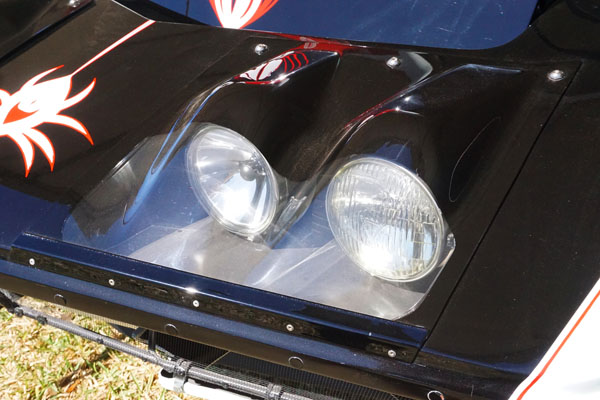 “Randy drew out the exact stripes layout and even the spider on the nose and hood. All of the pinstriping on the car is real, painted-on pin-striping, with no tape. Same with the numbers on the car and the black and red accents on the flairs. I had a ton of help from Jerry, and when we debuted the car at Daytona for the 2017 HRS 24 Hour and Daytona Historical event, Gib was there to make sure the setup for the brakes and suspension was correct. I could not have built this re-creation without the help from Gib, Jerry, and Randy.”
“Randy drew out the exact stripes layout and even the spider on the nose and hood. All of the pinstriping on the car is real, painted-on pin-striping, with no tape. Same with the numbers on the car and the black and red accents on the flairs. I had a ton of help from Jerry, and when we debuted the car at Daytona for the 2017 HRS 24 Hour and Daytona Historical event, Gib was there to make sure the setup for the brakes and suspension was correct. I could not have built this re-creation without the help from Gib, Jerry, and Randy.”
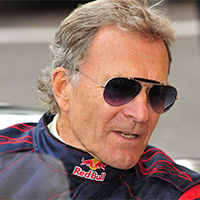
When the car debuted at the 2017 Daytona event, George hired veteran Austrian race car driver Deiter Quester to take the Owens-Corning re-creation for some hot laps on the Daytona banks. Deiter competed in 52, 24-hour racing events and is used to handling powerful race cars, so the pressure was on, not only to make the car safe to drive at speed, but also capable. Dieter drove the Corvette to 168-mph with the L88 roaring at the top of its lungs, 1970-style. Deiter said the car felt like he was riding a tornado! George recalls. “It was an amazing moment for Gib, Jerry, Randy, my crew, and myself. I’ll never forget it!”
Next, we will have a look at George’s 1966 24 Hours of Daytona Penske 1966 Corvette. – Scott

PS – We were able to get George’s Owens-Corning re-creation Corvette on the cover of Vette Vues!
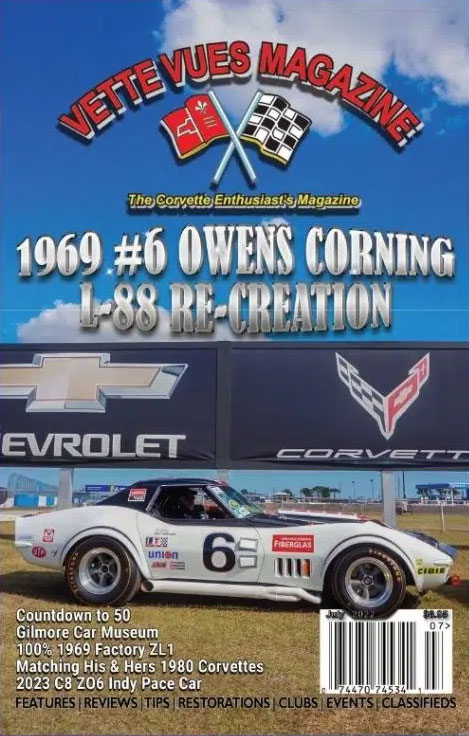
Vette Vues Magazine has been in continuous publication for 50 years!!!
To subscribe today, CLICK the below graphic!

In 2013 the restored Owens-Corning 1968 427 L88 Corvette race car sold for
$1,000,000!

